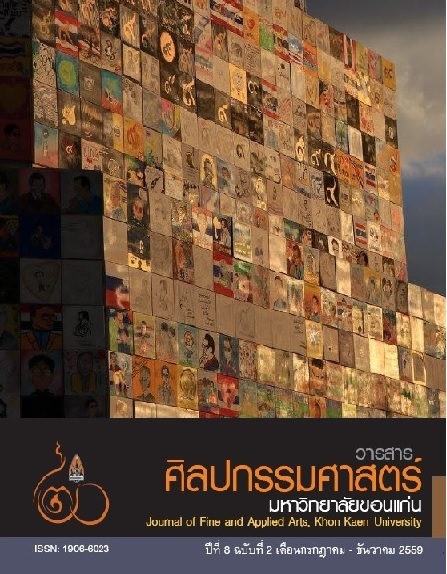วีณาธรีศิวะ –เครื่องดนตรีทิพย์: การศึกษาความแพร่หลายในอินเดีย และภูมิภาคเอเชียตะวันออกเฉียงใต้ และการศึกษาความหมายทางคติชนวิทยาในมิติแห่งเทพปกรณัม VINADHARI SHIVA –A DIVINE MUSICAL INSTRUMENT: THE STUDY OF DIFFUSION IN INDIA AND SOUTHEAST ASIA AND THE S
Main Article Content
บทคัดย่อ
การวิจัยเกี่ยวกับเครื่องดนตรีในตระกูลวีณาธรีศิวะ เป็นการวิจัยเชิงคติชนวิทยาในมิติแห่งเทพปกรณัม โดยใช้การรวบรวมข้อมูลและวิเคราะห์ข้อมูลแบบสหวิทยาการให้ครอบคลุมพื้นที่การวิจัยที่มีขอบเขตกว้างขวางในพื้นที่ประเทศสาธารณรัฐอินเดียและภูมิภาคเอเชียตะวันออกเฉียงใต้ คำว่า “วีณาธรีศิวะ” มีความหมายตรงตามอักษรว่าพระศิวะผู้ทรงถือวีณา ซึ่งลักษณะพิเศษคือเป็นเครื่องดนตรีชนิดนี้คือการครอบกล่องเสียงไว้ที่หน้าอกบริเวณหัวใจ การวิจัยดังกล่าวจึงเป็นการศึกษาความสัมพันธ์ของเครื่องดนตรีวีณาในวัฒนธรรมโลกที่เชื่อมโยงมาถึงต้นกำเนิดเครื่องดนตรีในตระกูลวีณาธรีศิวะในอินเดียโบราณ ที่ปรากฏความแพร่หลายในงานศิลปกรรมอันเนื่องมาจากความเชื่อในศาสนาพราหมณ์ –ฮินดู และศาสนาพุทธ ในวัฒนธรรมอินเดียโบราณและความแพร่หลายมาสู่ภูมิภาคเอเชียตะวันออกเฉียงใต้ โดยปรัชญาศาสนาที่แฝงอยู่ในรูปแบบทางประติมานวิทยาของศิลปกรรมรูปเครื่องดนตรีชนิดนี้ มีความเชื่อมโยงกับมิติทั้ง 3 คือ 1.มิติแห่งปัจเจกบุคคล 2.มิติแห่งสังคมและวัฒนธรรม และ 3. มิติแห่งเทพปกรณัม ประเด็นสำคัญที่สุดคือเครื่องดนตรีในตระกูลวีณาธรีศิวะแสดงความเชื่อมโยงกับสัจธรรมสูงสุดของศาสนาพราหมณ์ –ฮินดูอย่างเด่นในด้านความเชื่อมเรื่องความบริสุทธิ์ศักดิ์สิทธิ์ของแม่น้ำคงคาที่ไหลมาจากสวรรค์เพื่อชำระล้างบาปแก่สรรพชีพในโลกพิภพอย่างเด่นชัด
อนุภาคความหนาแน่นของเครื่องดนตรีในตระกูลวีณาธรีศิวะมีการกระจายตัวอยู่ในวัฒนธรรมอินเดียโบราณ และได้แพร่หลายมาสู่ภูมิภาคเอเชียตะวันออกเฉียงใต้ ปรากฏรูปแบบศิลปกรรมอันเนื่องมาจากศาสนาในกลุ่มรัฐโบราณที่ได้รับอิทธิพลจากอินเดียโบราณ ได้แก่ ศิลปะชวา ศิลปะจาม ศิลปะขอม ศิลปะทวารวดี และศิลปะพุกามที่เจริญรุ่งเรืองขึ้นต่อจากอินเดีย เมื่อรัฐโบราณในยุคต้นได้เสื่อมลงก็ปรากฏรัฐใหม่ที่เจริญรุ่งเรืองขึ้นมาภายหลัง ดังนั้น การศึกษาทางด้านศิลปกรรมในสังคมและวัฒนธรรมเอเชียตะวันออกเฉียงใต้ในปัจจุบัน จึงครอบคลุมพื้นที่ซึ่งปรากฏหลักฐานทางด้านศิลปกรรมเกี่ยวกับเครื่องดนตรีในตระกูลนี้ ได้แก่ ประเทศสาธารณรัฐอินโดนีเซีย ประเทศสาธารณรัฐสังคมนิยมเวียดนาม ประเทศสาธารณรัฐประชาชนกัมพูชา ประเทศไทย ประเทศสาธารณรัฐแห่งสหภาพเมียนมาร์ และประเทศสาธารณรัฐประชาธิปไตยประชาชนลาว
หลักฐานทางด้านศิลปกรรมแสดงให้เห็นการสืบทอดเครื่องดนตรีในตระกูลวีณาธรีศิวะจากอินเดียโบราณมาสู่ภูมิภาคเอเชียตะวันออกเฉียงใต้เป็นลำดับ โดยงานศิลปกรรมอันเนื่องมาจากศาสนาที่ปรากฏในภูมิภาคเอเชียตะวันออกเฉียงใต้มีการพัฒนารูปแบบไปตามความนิยมของกลุ่มชนต่างๆ จนกลายเป็นส่วนหนึ่งของวิถีชีวิตของกลุ่มชนและเป็นจิตวิญญาณที่ส่งต่อกันมาจากรุ่นสู่รุ่น ปรากฏชื่อเรียกเครื่องดนตรีในตระกูลวีณาธรีศิวะแตกต่างกันไปในพื้นที่วัฒนธรรมต่างๆ เช่น ตุยละ อุรวีณา ขะแซเฏียว พิณน้ำเต้า และพิณเปี๊ยะ เป็นต้น ในบางสังคมและวัฒนธรรมมีการสืบทอดองค์ความรู้และพัฒนารูปแบบเครื่องดนตรีให้เป็นส่วนหนึ่งของสังคมและอยู่มาถึงปัจจุบัน และบางสังคมและวัฒนธรรมก็เสื่อมความนิยมลงจนไม่ปรากฏอยู่ในปัจจุบัน ดังนั้น หลักฐานทางด้านศิลปกรรมจึงมีความสำคัญยิ่งต่อการสืบค้นและตีความทางรูปแบบศิลปะที่สามารถแสดงอนุภาคที่เชื่อมโยงไปถึงต้นแบบในอินเดียได้อย่างดีที่สุด
ข้อมูลในการวิจัยกับการตีความทางด้านคติชนวิทยาและการวิเคราะห์แบบสหวิทยาการ แสดงให้เห็นว่าเครื่องดนตรีในตระกูลนี้มีรูปแบบทาง ประติมานวิทยาที่แสดงถึงมหาปรัชญาแห่งพระศิวะมหาเทพทรงเครื่องดนตรีวีณา ที่สามารถเชื่อมโยงได้ถึงกระแสเสียงที่เป็นดั่งสายน้ำของแม่น้ำคงคาอันบริสุทธิ์ศักดิ์สิทธิ์ หลักฐานข้อมูลสนามที่ผู้วิจัยได้รวบรวมจากต้นแม่น้ำคงคาที่บริเวณโคมุขเชิงเขาศิวลึงค์ เรื่อยมาตามเมืองสำคัญต่างๆ เช่น อุตรกาสี จัมบา ฤๅษีเกศ หริทวาร และพาราณสี ปรากฏนัยสำคัญของแม่น้ำคงคาที่ประชาชนชาวอินเดียมีความเชื่อถือในความศักดิ์สิทธิ์สูงสุดกว่าแม่น้ำทั้งปวง สามารถชำระล้างบาปและความมัวหมองต่างๆให้หมดไปได้และนำเอาจิตวิญญาณของมวลมนุษย์กลับไปสู่พระผู้เป็นเจ้าบนสวรรค์ มหาปรัชญานี้จึงเป็นการเชื่อมโยงระหว่างเครื่องดนตรีในตระกูลวีณาธรีศิวะกับกระแสของแม่น้ำคงคาสวรรค์ได้อย่างลึกซึ้ง
ผลของการวิจัยแสดงให้เห็นว่าเครื่องดนตรีในตระกูลวีณาธรีศิวะ ที่ปรากฏลักษณะทางประติมานวิทยาเกี่ยวข้องกับพระศิวะมหาเทพ มีความสำพันธ์อย่างลึกซึ้งกับกระแสแห่งแม่น้ำคงคา โดยการตีความทางสัญลักษณ์และมหาปรัชญาได้ให้ความหมายเป็นอันหนึ่งอันเดียวกัน โดย “กาละ” หรือกาลเวลาอันยาวนานหลายพันปี และ “เทศะ” หรือสภาวะแห่งสถานที่ในสังคมและวัฒนธรรมต่างๆ ที่ผ่านการหล่อหลอม วิวัฒนาการและพัฒนารูปแบบของเครื่องดนตรีในตระกูลวัณาธรีศิวะนับแต่อดีตมาถึงปัจจุบัน เป็นเหตุผลที่ทำให้เครื่องดนตรีชนิดนี้เข้าไปเป็นส่วนหนึ่งของสังคมและวัฒนธรรมอินเดียและเอเชียตะวันออกเฉียงใต้ และความหมายที่ถูกปกปิดไว้ด้วยมายาแห่งพระผู้เป็นเจ้าที่ทรงสำแดงด้วยการดีดวีณา ในประเด็นสำคัญคือการบรรลุโมกษะหรือบรรลุสู่สัจธรรมสูงสุดโดยมีเครื่องดนตรีที่ครอบกล่องเสียงไว้ที่หัวใจเป็นสัญลักษณ์ มหาปรัชญานี้จึงคงไว้ซึ่งพระราชกระแสอันเป็นทิพย์ที่จรรโลงโลกไว้ตลอดมาและตราบชั่วนิรันดร์
A research of the ‘Vinadhari Shiva’ musical instrument is the folkore research in the Mythology dimension. The interdisciplinary data collection and analysis is applied to cover the wide study scope in the areas of Republic of India and the Southeast Asia region. The word ‘Vinadhari Shiva’ has the literal meaning of Shiva who holds a Vina. A special characteristic of this kind of musical instrument is to cover larynx at a chest in the area of heart. Therefore, such research is studying relation of Vina in the global culture linked with an origin of the ‘Vinadhari Shiva’ musical instrument in the ancient Indian era. It appears popularity of arts resulting from beliefs in Brahman-Hindu and Buddhism,both religions of the ancient Indian culture and popularity through the Southeast Asia region. The religious philosophy in the form of Art Iconography of this musical instrument links with 3 dimensions as follows: 1. Dimension of individual, 2. Dimensions of society and culture, and 3. Dimension of Mythology. The most significant issue is the ‘Vinadhari Shiva’ musical instrument obviously demonstrates linkage with the highest truth of Brahman-Hindu in respect of purity and sanctity of the Ganges River flowing from a heaven to distinctly expiate to all of life in the world.
Intensity particle of the ‘Vinadhari Shiva’ musical instrument was widespread in the ancient Indian culture and spread to the Southeast Asia region. It appeared in the form of arts resulted from religions in the ancient states which had been influenced from the ancient Indian era such as Javanese Art, Cham Art, Khmer Art, Dvaravati Art, and Bagan Art that flourished after the Indian era. When the ancient states in the early era declined, the new flourishing states appeared later.Thus,the current art study of Southeast Asia society and culture covers the areas appeared art evidences of this kind of musical instrument in Republic of Indonesia,Socialist Republic of Vietnam, People’s Republic of Kamphuchea, Kingdom of Thailand,Republic of the Union of Myanmar and The lao People Democratic Republic.
The art evidences demonstrate inheritance of the ‘Vinadhari Shiva’ musical instrument’ from the ancient Indian era to the Southeast Asia region respectively. The art patterns resulted from religions appeared in the Southeast Asia region have been developed in accordance with the popularity of various groups until they become one part of lifestyle and spirit transferred to next generation. The name of the ‘Vinadhari Shiva’ musical instrument differs in the diverse cultural areas such as Tuila, Uravina, Khasaetueo, lute, and Pin Phia lute, etc. For some societies and cultures, inheriting knowledge and developing the pattern of musical instrument to be one part of society has been performed until present. Therefore, the art evidences are very important for searching and interpreting the art patterns which demonstrate the particle to link with the Indian model efficiently.
The research information, the folklore interpretation, and the interdisciplinary analysis demonstrate that this musical instrument has the Iconography pattern which indicates the great philosophy of Great Shiva who played a vina. It can link sound as current of the pure and sacred Ganges River. The field information that a researcher has collected from the source of the Ganges River in the Komuk area of Shiva lingam foothill throughout important cities such as Uttarkashi, Chamba, Rishikesh, Haridhawar, and Varanasi appeared the significance of the Ganges River where the Indian people believe in its sanctity rather than all rivers. They can expiate sins and eliminate blemish and return spirit of humans to the God in the heaven. Thus, this great philosophy is deep linkage between the ‘Vinadhari Shiva’ musical instrument and the Heaven Ganges river.
The result of this research demonstrates that the ‘Vinadhari Shiva’ musical instrument appeared in the form of Iconography relates to the Great Shiva, deeply involves in the current of the Ganges river. The symbol and great philosophy interpretation provides the unique meaning. The word “Kala” or thousand years in the past and “Dhesa” or the state of places in the society and cultures were taught, evolved, and developed the ‘Vinadhari Shiva’ musical instrument from the past until the present. This is the reason that this musical instrument in one part of Indian and Southeast Asia region society and culture. Its meaning is concealed by the illusion of God who performed his power by playing a vina. The important issue is to pursue nirvana or the highest truth with the musical instrument which covers larynx in heart as a symbol. Therefore, this great philosophy has maintained royal words as nectar to sustain the world until present and forever.
Article Details
เนื้อหาและข้อมูลในบทความที่ลงตีพิมพ์ในวารสารคณะศิลปกรรมศาสตร์ มหาวิทยาลัยขอนแก่น ถือเป็นความคิดเห็นและความรับผิดชอบของผู้เขียนบทความโดยตรง ซึ่งกองบรรณาธิการไม่จำเป็นต้องเห็นด้วย หรือร่วมรับผิดชอบใด ๆ
บทความ ข้อมูล เนื้อหา รูปภาพ ฯลฯ ที่ได้รับการตีพิมพ์ในวารสารคณะศิลปกรรมศาสตร์ มหาวิทยาลัยขอนแก่น ถือเป็นลิขสิทธิ์ของวารสารคณะศิลปกรรมศาสตร์ มหาวิทยาลัยขอนแก่น หากบุคคลหรือหน่วยงานใดต้องการนำทั้งหมดหรือส่วนหนึ่งส่วนใดไปเผยแพร่ต่อหรือเพื่อกระทำการใด ๆ จะต้องได้รับอนุญาตเป็นลายลักอักษรจากวารสารคณะศิลปกรรมศาสตร์ มหาวิทยาลัยขอนแก่น ก่อนเท่านั้น


